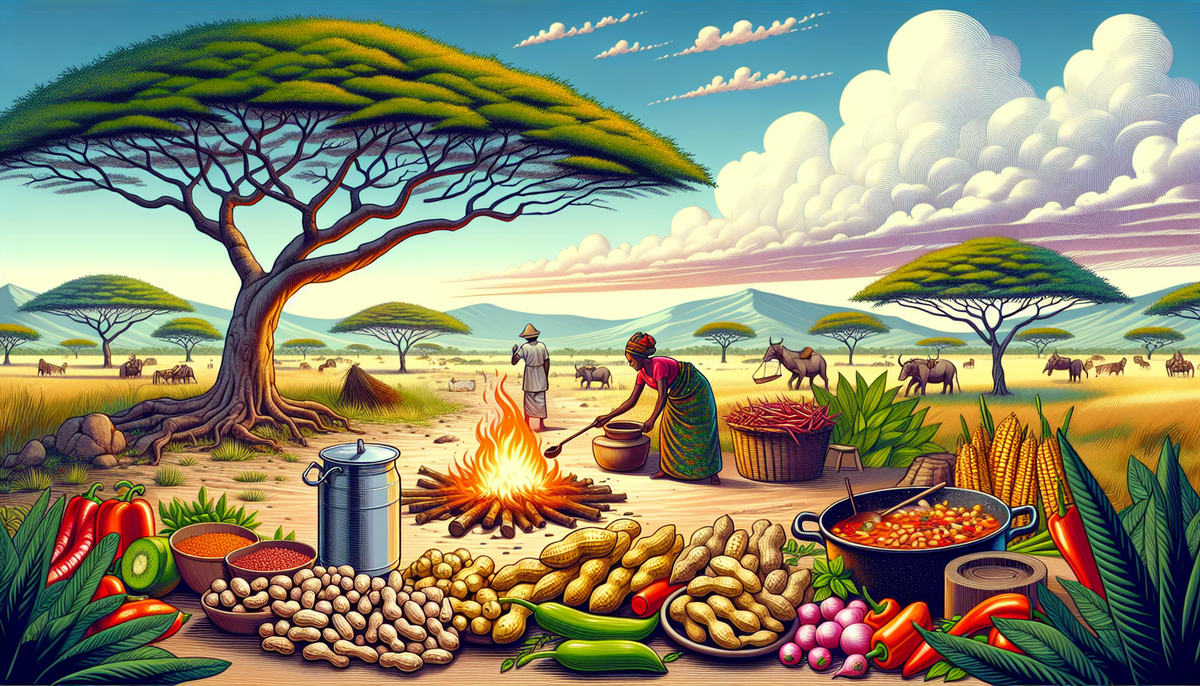The Dominance of Nature in African Culinary Practices

Influence of Local Flora on Traditional Dishes
The rich tapestry of African culinary practices is intricately woven with the diverse local flora that thrives across the continent. Each region boasts a unique array of plants, fruits, and vegetables that deeply influence traditional dishes. For example, in West Africa, the use of indigenous ingredients like yams, cassava, and plantains is foundational, shaping not only the meals but also cultural identities. These staple foods are often transformed into fufu or pounded yam, which serve as vehicles for a variety of sauces and stews, celebrating the flavors of the land.
In East Africa, vegetables such as sukuma wiki (collard greens) and various legumes play a crucial role in everyday cooking, showcasing a commitment to nutritional balance and flavor. The incorporation of local herbs, like garlic and ginger, further enhances the vibrant dishes and reinforces the connection to the surrounding environment.
Moreover, unique fruits like baobab and marula are not only enjoyed fresh but also integrated into beverages, desserts, and traditional remedies. This symbiosis between cuisine and local plant life highlights the importance of sustainability and biodiversity, as communities continue to rely on the gifts of nature, passing down these culinary traditions through generations while adapting to modern influences.
Utilization of Indigenous Spices and Seasonings
Indigenous spices and seasonings are at the heart of African cuisine, transforming simple ingredients into vibrant, flavorful dishes. Across the continent, culinary traditions have evolved around locally sourced spices that reflect the diverse climates and ecosystems. In North Africa, for instance, spices such as cumin, coriander, and paprika are integral to recipes like tagines and couscous, imparting warmth and depth to each bite.
In West Africa, the use of groundnut (peanut) paste and fiery chili peppers plays a pivotal role, enhancing the taste profile of popular dishes such as groundnut stew and jollof rice. The balance of sweetness, heat, and earthiness creates an unforgettable flavor experience that is quintessentially African. Similarly, East African cuisines often incorporate spices like cardamom and cloves, found in dishes such as pilau and biryani, showcasing a blend of influences from trade and migration.
Moreover, indigenous condiments, such as harissa and peri-peri, not only accentuate flavors but also celebrate regional identities. By utilizing these local spices and seasonings, African chefs and home cooks honor their heritage while contributing to the culinary diversity of the continent. This connection to indigenous ingredients fosters a deep appreciation for the flavors that define African cuisine and its enduring legacy.
Impact of Climate on Food Preservation Techniques
The diverse climates of Africa have profoundly shaped food preservation techniques that are essential for sustaining communities. With vast variations, from arid deserts to lush rainforests, local climatic conditions dictate the methods used to store and extend the shelf life of perishable items. In the dry regions, particularly in the Sahel, sun-drying is a prevalent technique. Foods such as fish, fruits, and vegetables are laid out in the sun, allowing moisture to be evaporated and inhibiting spoilage.
In contrast, regions with more humidity, like West Africa, often employ fermentation as a preservation method. This technique not only extends the life of food but also enhances its nutritional profile and flavor. For example, fermented foods such as garri and ogi are staples that utilize native grains like cassava and maize. The warm, moist climate facilitates the growth of beneficial bacteria, transforming simple ingredients into probiotic-rich delights.
Additionally, smoking is another widespread preservation technique, particularly for meat and fish. This method, favored in various climates, imparts a unique flavor while preventing microbial growth. Overall, the interplay between climate and food preservation techniques underscores the ingenuity of African communities in adapting to their environments, ensuring food security and cultural continuity for generations.
Integration of Ritual and Feast in Meal Preparations
In many African cultures, the integration of ritual and feast into meal preparations is a deeply rooted tradition that goes beyond mere sustenance. These practices reflect the communal values, spiritual beliefs, and social cohesion within various communities. Meals are often central to important life events such as births, weddings, and funerals, transforming food into a means of expressing love, gratitude, and respect.
Rituals associated with meal preparation often involve symbolic actions, such as the blessing of ingredients or the communal cooking process, which brings families and communities together. For instance, in many regions, particular dishes are prepared during festive seasons and are associated with ancestral worship or giving thanks, such as in the harvest ceremonies celebrated in several agricultural societies.
Feasting serves as a way to strengthen social bonds, where families and friends gather to share elaborate meals that showcase culinary skills and cultural heritage. Traditional foods, prepared with care, are often infused with historical significance, representing ancestral knowledge and practices that have been passed down through generations. By intertwining food and ritual, these practices not only honor the past but also foster a sense of belonging and identity, celebrating the richness of African culture through shared culinary experiences.
Harvesting Wild Ingredients from Diverse Ecosystems
Africa's diverse ecosystems provide a treasure trove of wild ingredients that play a vital role in traditional culinary practices. From the lush savannas to dense rainforests, indigenous communities have long harnessed the bounty of nature, foraging for edible plants, mushrooms, nuts, and fruits that enhance their diets and flavors. This practice not only supports food security but also fosters a deep connection to the environment.
For instance, in the Eastern Cape of South Africa, the sour fig, or "suurvygie," is harvested for its tangy flavor and high vitamin content, often enjoyed fresh or used in traditional dishes. Similarly, in the Niger Delta, the nuts of the African oil palm are collected and processed into oil, a staple ingredient that adds richness to numerous local recipes.
Communities often hold knowledge of seasonal availability and sustainable harvesting methods, ensuring that wild foods are gathered without depleting resources. This balance reflects a profound respect for nature, emphasizing the importance of biodiversity. The integration of wild ingredients into daily meals not only showcases culinary diversity but also preserves cultural identity, as these flavors and practices are passed down through generations, celebrating the intricate relationship between people and their environment.
Sustainability Practices in Contemporary Cooking Methods
Sustainability has become a guiding principle in contemporary cooking methods, particularly as chefs and home cooks are increasingly aware of the environmental impact of their culinary choices. In Africa, this shift is evident through various practices that promote resource conservation and minimize waste. One prominent approach is the emphasis on using locally sourced ingredients, which reduces carbon footprints associated with transportation, promotes local economies, and supports biodiversity.
Farm-to-table movements have gained traction, encouraging chefs to cultivate relationships with local farmers and foragers. This not only ensures fresh produce but also encourages the use of seasonal ingredients, aligning culinary practices with natural growing cycles. Additionally, many chefs embrace the use of traditional preservation techniques, such as fermentation and drying, to extend the shelf life of foods and reduce spoilage.
Moreover, contemporary cooking methods often integrate plant-based proteins, reducing reliance on meat and contributing to more sustainable diets. Innovative approaches to reducing food waste, such as repurposing vegetable scraps or incorporating leftovers into new dishes, further emphasize sustainability. These practices not only honor African culinary heritage but also align with global efforts to create a more sustainable food system, promoting a holistic view of cooking that respects both culture and the environment.
Adaptation of Meals to Various Geographical Landscapes
Africa's diverse geographical landscapes have profoundly influenced the adaptation of meals across the continent. Each region's climate, soil, and available resources have shaped culinary practices and ingredient choices, resulting in a rich tapestry of flavors and dishes. In coastal areas, such as East Africa, the abundance of fresh seafood has led to the development of vibrant dishes that celebrate local fish, accompanied by spices and coconut milk. Staples such as Swahili biryani showcase this integration of marine resources with aromatic spices unique to the region.
In contrast, the arid landscapes of the Sahel region see a reliance on drought-resistant grains and legumes. Traditional meals often include millet, sorghum, and beans, which are not only nutritious but also well-suited to the challenging environment. Dishes like couscous or porridge are common, reflecting the resourcefulness of people who adapt to their surroundings.
In mountainous regions, altitude influences agricultural practices, leading to unique adaptations such as the cultivation of potatoes and other root vegetables. Here, hearty stews and slow-cooked dishes provide warmth and sustenance against cooler temperatures. By leveraging the distinct geographical characteristics of their regions, communities create meals that are both nourishing and representative of their cultural identities, illustrating a profound connection between landscape and cuisine.



